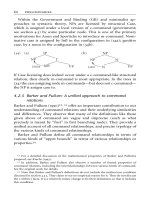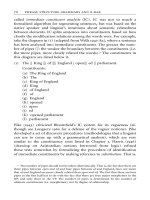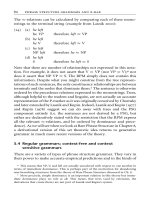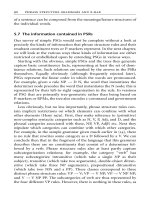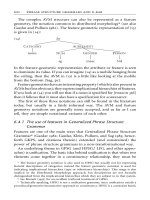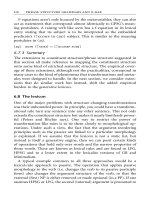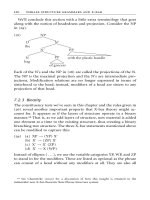Constituent Structure - Part 14
Bạn đang xem bản rút gọn của tài liệu. Xem và tải ngay bản đầy đủ của tài liệu tại đây (98.97 KB, 10 trang )
F-equations aren’t only licensed by the metavariables; they can also
act as statements that correspond almost identically to GPSG’s mean-
ing postulates. A raising verb like seem has a f-equation in its lexical
entry stating that its subject is to be interpreted as the embedded
predicate’s ("xcomp in (29)) subject. This is similar to the meaning
postulates in (23).
(29) seem ("subj) ¼ ("xcomp subj)
6.7.3 Summary
The extensions to constituent structure/phrase structure suggested in
this section all make reference to mapping the constituent structure
onto some kind of enriched semantic structure. The empirical cover-
age of these extensions, although not the practicalities, correspond in
many cases to the kind of phenomena that transformations and metar-
ules were designed to handle. In the next section, we consider exten-
sions that do similar work but instead, shift the added empirical
burden to the generative lexicon.
6.8 The lexicon
One of the major problems with structure-changing transformations
was their unbounded power. In principle, you could have a transform-
ational rule turn any sentence into any other sentence. This not only
extends the constituent structure but makes it nearly limitlessly power-
ful (Peters and Ritchie 1973). One way to restrict the power of
transformation-like rules is to tie them closely to morphological op-
erations. Under such a view, the fact that the argument-reordering
principles such as the passive are linked to a particular morphology
is explained. If we assume that the lexicon is not a static list, but
instead is itself a generative engine, then we can posit certain kinds
of operations that hold only over words and the narrow properties of
those words. These are known as lexical rules and are found in LFG,
HPSG and to a lesser extent in the lexicalist versions of GB and
Minimalism.
A typical example common to all three approaches would be a
lexical-rule approach to passive. The operation that applies passive
morphology to the verb (i.e. changes the verb to its passive participle
form) also changes the argument structure of the verb, so that the
external (Wrst) NP is either removed or made optional (in a PP). If one
assumes HPSG or LFG, the second (internal) argument is promoted to
110 phrase structure grammars and x-bar
the Wrst position. If one is assuming GB, then the promotion of the
internal argument happens via a movement rule in the syntax. Either
way, the operation is lexically restricted.
The addition of the generative lexicon thus provides an extension to
phrase structure grammars that allows a constrained account of some
of the phenomena that a PSG cannot handle.
6.9 Conclusion
Phrase structure grammars and the trees they generate are useful and
powerful tools. They can account for a wide range of constituency and
related facts. However, they are also simultaneously more and less
powerful than is necessary for accounting for human language. In
this chapter, we have looked at some of the extensions to PSGs
(transformations, features, metarules, lexical rules, ID/LP format,
meaning postulates and metavariables) that might allow a greater
range of empirical coverage. In the next chapter, we consider X-bar
theory, which places restrictions on the form of PSGs and—under
some approaches—actually leads to the elimination of PSGs as the
primary means of generating constituent structure.
extended phrase structure grammars 111
7
X-bar Theory
7.1 Introduction
Phrase structure grammars and their extensions provide us with
powerful tools for describing constituent structures, but the range
and extent of their adequacy is a matter of debate. There is, however,
one particular extension to phrase structure grammars that has been
almost universally adopted at one point or another by formal linguists:
X-bar theory. X-bar theory serves both as an extension to phrase
structure grammars and places a number of restrictions on the form
that phrase structure rules (PSRs) can take. We start this discussion by
looking at some of the ways in which PSRs are not powerful enough or
the ways in which they fail to capture the right level of generalization,
and the ways in which they can be too powerful and can over-generate.
These will serve as the motivations for some of the central ideas of
X-bar theory. Then we turn to the history of X-bar theory and take a
look at how it has been variously implemented in grammatical theory.
7.2 Simple PSGs vs. X-bar theoretic PSGs
7.2.1 Headedness
There are a number of ways in which PSGs are overly powerful. Let us
start with the relationship between the phrasal element and the cat-
egories that rewrite it. Consider the sentences in (1):
(1) (a) The cat was running along the fence-posts.
(b) Running along fence-posts is dangerous for your health.
Let us assume that was in (1a) is merely a representation of tense and
aspect.1 This means that, all other things being equal, the gerund
running in (1a) is a verb in the sentence. In (1b) by contrast, a nearly
1 This is not an uncontroversial assumption, but we will use it here as a starting
position.
identical phrase to the italicized phrase in (1a) is used as the subject of
the sentence and thus has a nominal character. Let us assume that the
italicized phrase (in 1a) was partly created by the PSR VP! V PP; it
seems not unreasonable that we could deal with the nearly identical
phrase in (1b) with a similar rule NP ! V PP. The odd thing about this
rule is that there is no noun in this NP. It seems to be compatible with
the data and there is nothing in the PSG formulation that prevents
rules from not having a clear head. In fact, in many PSGs there
is usually at least one rule, S ! NP VP, which crucially is non-headed.
In early generative grammar2 one often found examples of other non-
headed rules, such as NP ! S’. This allows the embedding of tensed
clauses in positions otherwise restricted to NPs:
(2) (a) [
NP
Loud noises] bother Andy.
(b) [
NP
[
S’
That categories are fuzzy]] bothers Andy.
These rules appear then to have empirical motivation. On the other
hand, they also seem to signiWcantly overgenerate, as seen in the
application of NP ! VPPin(3):
(3) *Ran along the fence posts is dangerous for your health.3
This sentence is also generated by the unheaded NP rule. Controlling
for this type of overgeneration might involve avoiding non-headed
rules and generating pairs like (1a, b) by some other means.
The requirement that a phrase bear the same category as its head is
known as ‘‘endocentricity’’. Using the variable X to stand for any
category, we can schematize this as (4). This is the simple requirement
that a phrase (XP) be of the same category as some semantically
prominent word (the head) in it. The X here is the ‘‘X’’ in ‘‘X-bar
theory’’.
(4)XP! ...X...
As we will see in this chapter, the exact interpretation of what this
rule means varies from author to author and from theory to theory,
but for now the reader can take this to be simply a metaconstraint
2 In fact, unheaded constituents are still common in Lexical-Functional Grammar
(Bresnan 2001).
3 The ungrammaticality of (3) might be controlled through the judicious use of features
(NP ! V
[ÀTense]
PP). In addition, the notion of what it means to be a noun or verb or any
other category is not at all clear, but the complex discussion over syntactic categories lies
well beyond the scope of this book. See Baker (2003) and the references cited therein for a
view of this controversial topic.
x-bar theory 113
on the form of phrase structure rules, such that it prohibits rules such
as NP ! VPP.
7.2.2 Structural refinement 4
The discussion that follows in this section is not a criticism of the
formalism of PSGs nor even of their empirical coverage. Indeed, the
distinctions we make here be captured easily in a PSG. Instead, what
is at stake is a question of whether or not a simple PSG properly
captures the right generalizations at the right level of abstraction of
syntactic structure.
One of the innovations of the 1970s (see in particular JackendoV
1977) was the realization that syntactic structure is signiWcantly more
reWned than the PSGs of the 1950s and 1960s might suggest. Consider,
for example, the NP the big bag of groceries with the plastic handles
and take the constituency test of replacement. There is a particular
variety of this process, one-replacement, that seems to target a con-
stituent that is smaller than the whole phrase and larger than the
head word:
(5) I bought the big [bag of groceries with the plastic handle] not the
small [one].
One-replacement seems to be able to target other subgroups inter-
mediate in size between the phrase and the head:
(6) I bought the big [bag of groceries] with the plastic handle, not
the small [one] with the ugly logo.
These facts seem to point to a more reWned structure for the NP:
()NP
DN
1
Ј
the
AdjP N
2
Ј
big N
3
Ј PP
N PP with the plastic handles
bag
of
groceries
4 Parts of the discussion in this section, including examples, is based on Carnie (2006).
114 phrase structure grammars and x-bar



